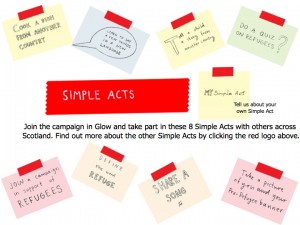

Glow Scotland blog
 Are you involved in Refugee Week’s Simple Acts? Well why not add to the many Simple Acts that you can achieve by signing up for Do a Quiz on Refugees?
Are you involved in Refugee Week’s Simple Acts? Well why not add to the many Simple Acts that you can achieve by signing up for Do a Quiz on Refugees?
Find out some interesting facts you never knew and take part in our quiz about refugees. Did you know that Fish and Chips is not a British dish? Can you think of a famous politician who is from a refugee family? Which countries do you think most refugees come from and which countries do they end up in? Find out these answers and more in our quiz and bring along any questions you might have.
It’s not too late to sign up and join us in the Simple Acts National Glow Group.
MoreStormy Sunset
Andy Garnett was runner up with his Stormy Sunset in Angus Council’s local competition for an image for Glow light.
Sunset or sundown is the daily disappearance of the Sun below the horizon in the west as a result of Earth’s rotation.
The time of sunset is defined in astronomy as the moment the trailing edge of the Sun’s disk disappears below the horizon in the west. The ray path of light from the setting Sun is highly distorted near the horizon because of atmospheric refraction, making astronomical sunset occur when the Sun’s disk is already about one diameter below the horizon. Sunset is distinct from dusk, which is the moment at which darkness falls, which occurs when the Sun is approximately eighteen degrees below the horizon. The period between the astronomical sunset and dusk is called twilight.
Locations north of the Arctic Circle and south of the Antarctic Circle experience no sunset or sunrise at least one day of the year, when the polar day or the polar night persist continuously for 24 hours.
Sunset creates unique atmospheric conditions such as the often intense orange and red colors of the Sun and the surrounding sky.
Image: Andy Garnett Angus Coucil/Text: Wikipedia.
More Mary’s Meals Glow Meet on Wednesday 1st June, International Children’s Day
Mary’s Meals Glow Meet on Wednesday 1st June, International Children’s Day
10.30 to 11.30 am
Mary’s Meals is an international movement to set up school feeding projects in communities where poverty and hunger prevent children from gaining an education. Mary’s Meals provides daily meals in school for over 500,000 children in Africa, Asia, Latin America and Eastern Europe.
This Glow Meet will launch case study materials for Global Citizenship and Interdisciplinary Learning. Suitable for primary and secondary pupils and teachers throughout Scotland.
Taking part are former First Minister Lord McConnell and P6 pupils from Stonehouse Primary School and neighbouring Newfield Primary School.
Learning about those who benefit from Mary’s Meals projects and the lives that they lead, is a great tool for learning about global citizenship and developing citizenship skills, by discussing the part that we have to play in international society.
A Mary’s Meals project can be an exciting whole school learning experience, creating excellent opportunities for InterdisciplinaryLearning, a key feature of A Curriculum for Excellence. New Classroom resources and online materials will be available after the Glow Meet.
Click here to view a recording of this Glow Meet
More Do you know how supermarkets ripen bananas, or how many times a day lightning strikes the earth, or why animals migrate? The answers to these and many more questions can be found on the Glow Science website, the media-rich teaching online resource with over 500 short films mapped to Curriculum for Excellence experiences and outcomes. Supported by learning materials and ideal for revision purposes, these short films will motivate and engage learners.
Do you know how supermarkets ripen bananas, or how many times a day lightning strikes the earth, or why animals migrate? The answers to these and many more questions can be found on the Glow Science website, the media-rich teaching online resource with over 500 short films mapped to Curriculum for Excellence experiences and outcomes. Supported by learning materials and ideal for revision purposes, these short films will motivate and engage learners.
Glow Science covers the four science disciplines: biology, chemistry, physics and earth science. The website has just been updated with 130 new short films focussing on chemistry and physics, and covering everything from the periodic table to Newton’s laws of motion.
Glow Science films have been produced by experienced television writers and editors working closely with teachers and scientists, bringing science to life with stunning visuals, engaging music and clear graphics.
Glow Science films are supported by learning materials written by teachers. These include quizzes, diagrams and handouts and examples of classroom activities and discussions.
You will need your Glow user name and password to access the full range of Glow Science materials.
MoreStill Waters
This week’s image was taken by Kyle, an S3 pupil at Wellington Special School, in Edinburgh. The school photography club went up Flotterstone path in the Pentland Hills. Reaching Glencorse Reservoir, Kyle commented on how still the water was and how it seemed to be ‘made of glass’. His photograph was the winning entry in the special school category of the Glow Light competition organised by the Edinburgh Glow team.
The Pentland Hills Regional Park is a living, working landscape, which offers great opportunities to experience and enjoy the outdoors. With approximately 10,000 hectares of countryside and over 100km of paths, the Pentland Hills are a great place to come walking, biking, horse riding as well as fishing.
Outdoor Learning is an important approach in the new Curriculum for Excellence. The Pentland Hills Ranger Service can provide opportunities for schools to participate in enjoyable, active and challenging activities in an outdoor setting which contributes to delivering the Curriculum for Excellence. Curriculum areas include Social Studies, Sciences and Health & Wellbeing. If you would like to know more about what they can offer then please contact the Ranger Service for more information.
Pentland Hills Ranger Service
Regional Park Headquarters
Boghall Farm
Biggar Road
Edinburgh
EH10 7DX
Tel: 0131 445 3383
E-mail: [email protected]
Web Site:www.pentlandhills.org.uk
Text Pentland Hills Ranger Service website.
More The 2010 spending review agreement between the Scottish Government and the Convention of Scottish Local Authorities, published in November 2010, included an agreement to an Independent Review of all aspects of the terms and conditions for Scotland’s teachers. The Review was announced on 28 January 2011 and it is charged with publishing recommendations in the summer of this year, aimed at improving educational outcomes for our children and young people.
The 2010 spending review agreement between the Scottish Government and the Convention of Scottish Local Authorities, published in November 2010, included an agreement to an Independent Review of all aspects of the terms and conditions for Scotland’s teachers. The Review was announced on 28 January 2011 and it is charged with publishing recommendations in the summer of this year, aimed at improving educational outcomes for our children and young people.
A Call for Evidence was issued on 23 February and closed on 21 April. During this Glow Meet, Professor Gerry McCormac, Chair of the Review, will share some of the results of the call for evidence exercise while asking your views on current terms and conditions.
This is an opportunity to hear the latest from the Review and put your views directly to the Chair.
Sign up and join us in Glowing Thursdays on the 19th May from 4-5pm - it is vital that he hears your views!
More The season of Simple Acts continues on Wednesday the 18th May at 11am. Why not join us to learn more about the Simple Act of ‘Cooking a Dish from Another Country’?
The season of Simple Acts continues on Wednesday the 18th May at 11am. Why not join us to learn more about the Simple Act of ‘Cooking a Dish from Another Country’?
Tickle your taste buds with new sensations as they cook a dish from Iraq, with the special ingredient of Cardomom. Follow step by step as you too make Iraqi Cardomom Cookies. The scent of a country can be realised through its food, so let the smell fill the air and enjoy the cookies.
The full recipe is available in the Simple Acts Glow Group when you sign up so you can cook along with Victoria Beesly or watch and try cooking the lovely cookies later on. Join us and find out more not only about cooking delicious cookies and the story behind their original creation but also about the country that they come from!
Sign up and join us on Wednesday 18th May in the Simple Acts Glow Group.
MoreTrees & Daffodils
This week’s image was taken by Kelly, an S5 pupil at Tynecastle High School in Edinburgh. Kelly said “I was returning home from a course at college and saw the light coming through the trees and thought it would make a good photo”. Her photograph was the winning entry in the secondary school category of the Glow Light competition organised by the Edinburgh Glow team. Originally taken in portrait, it has been cropped for Glow Light.
Harrison Park is a small urban park in Edinburgh, which is well cared for and valued by local people. The park sits alongside the Union Canal, which provides a valuable wildlife corridor in the area.
In 2008 Harrison Park was awarded Green Flag status – one of the first flags issued in Scotland. The scheme aims to encourage safe, clean and accessible public parks which are managed in an environmentally sustainable way.
History of the Park
The eastern part of Harrison Park first came under control of the Corporation in 1886 with a 15 year feu of 13.92 acres from George Watson’s Hospital plus an additional 1.375 acres were feued in 1902 for a bowling green and playground. The park is split in two by Harrison Road, with a playground and football pitches on the east side.
The western portion was purchased for £10,000 from the Merchant Company Education Board on 15 May 1930.
In 2000, North Merchiston Boys Club requested outline planning permission from Edinburgh Council to demolish their current facilities, erect private flats on the premises and build a new sports centre on open parts of the park. Following a campaign from residents surrounding the park, the application was refused. The council then carried out a consultation with surrounding residents and stake holders and came up with a development plan. This resulted in the old bowling green and the tennis courts being removed and turned over to grass.
Text on Harrison Park came from the Friends of Harrison Park website, http://www.harrisonpark.org.uk/, who gave use permission to use any of the text on their website.
MoreBee in Flight
This fantastic photograph is one of three winning entries in Edinburgh’s Glow Light competition. It was taken by Iona, P7, St Mary’s RC Primary. Iona is a member of St Mary’s RC Primary Photography Club. She tells us:
“I was standing with my camera for a long time taking photos of the bees until I finally got one in focus.”
Bees are flying insects closely related to wasps and ants, and are known for their role in pollination and for producing honey and beeswax. There are nearly 20,000 known species of bees in seven to nine recognized families, though many are undescribed and the actual number is probably higher. They are found on every continent except Antarctica, in every habitat on the planet that contains insect-pollinated flowering plants.
Bees are adapted for feeding on nectar and pollen, the former primarily as an energy source and the latter primarily for protein and other nutrients. Most pollen is used as food for larvae.
Bees have a long proboscis (a complex “tongue”) that enables them to obtain the nectar from flowers. They have antennae almost universally made up of 13 segments in males and 12 in females, as is typical for the superfamily. Bees all have two pairs of wings, the hind pair being the smaller of the two; in a very few species, one sex or caste has relatively short wings that make flight difficult or impossible, but none are wingless.
The smallest bee is Trigona minima, a stingless bee whose workers are about 2.1 mm (5/64″) long. The largest bee in the world is Megachile pluto, a leafcutter bee whose females can attain a length of 39 mm (1.5″). Members of the family Halictidae, or sweat bees, are the most common type of bee in the Northern Hemisphere, though they are small and often mistaken for wasps or flies.
The best-known bee species is the European honey bee, which, as its name suggests, produces honey, as do a few other types of bee. Human management of this species is known as beekeeping or apiculture.
Image: Iona, P7, St Mary’s RC Primary, Edinburgh/Text: Wikipedia
More Simple Acts is about inspiring individuals to use small, everyday actions to change perceptions of refugees.
Simple Acts is about inspiring individuals to use small, everyday actions to change perceptions of refugees.
It consists of 20 actions that can be done by anyone and that encourage us to learn and do more with refugees. With every person who joins in on the idea and does a small thing with and for refugees, we get a little closer to removing barriers between communities and to creating the kind of world we all want to live in.
There’s no way of knowing an exact number, but we hope to see thousands of people doing at least one small action by 2011!
Glow is getting involved in these Simple Acts this May and June with a series of Glow Meets that everyone can join in with. On Wednesdays from 11- 12pm you can join in and do such things as listening to a story from another country, learning a few things in a different language and doing a quiz on refugees and much more!!
All these events which will be running each Wednesday from 11th May to 8th June are highlighted on the National Calendar and you can find out more about the 8 Simple Acts the Glow are supporting in the new Simple Acts Glow Group.
Make sure you join us for our first Simple Act on Wednesday 11th May which will be ‘Telling a Child a Story from Another Country’. Join us to hear some stories and you can share one of your own if you have one!
Sign up and join us for this exciting event from 11am on 11th May!
More
Find us on